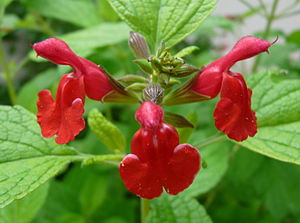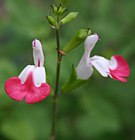Note: This is a project under development. The articles on this wiki are just being initiated and broadly incomplete. You can Help creating new pages.
Difference between revisions of "Salvia microphylla - Baby sage"
(Created page with "thumb|right|''Baby sage'', ''Salvia microphylla'' '''Salvia microphylla''' ('''Baby sage, Graham's sage, Blackcurrant sage''') is a p...") |
(→References) |
||
| (29 intermediate revisions by 3 users not shown) | |||
| Line 1: | Line 1: | ||
[[File:Salvia microphylla neurepia.jpg|thumb|right|''Baby sage'', ''Salvia microphylla'']] | [[File:Salvia microphylla neurepia.jpg|thumb|right|''Baby sage'', ''Salvia microphylla'']] | ||
| − | '''Salvia microphylla''' | + | '''Salvia microphylla''' is a perennial shrub found in the wild in southeastern Arizona and the mountains of eastern, western, and southern Mexico. It is a very complex species which easily hybridizes, resulting in numerous hybrids and cultivars brought into horticulture since the 1990s. |
| − | == | + | ==Uses== |
| − | + | {{Uses|Fever}}. | |
| − | |||
| − | + | ==Parts Used== | |
| + | {{Parts Used|Roots}}, {{Parts Used|Bark}}, {{Parts Used|Leaves}}. | ||
| − | == | + | ==Chemical Composition== |
| − | + | 1‐diphenyl‐2‐picrylhydrazyl (DPPH) and β‐carotene/linoleic acid tests were used to determine the antioxidant activity. Terpin‐4‐ol (14.95%), sabinene (13.07%) and γ‐terpinene (11.22%) were found to be the major constituents in the essential oil of M. fragrans by gas chromatography, whereas (E)‐caryophyllene (15.35%), α‐eudesmol (14.06%), β‐eudesmol (8.74%) and γ‐eudesmol (7.64%) were encountered in the essential oil of S. microphylla.<ref name="chemical composition"/> | |
| − | |||
| − | |||
| − | == References == | + | ==Common names== |
| − | + | {{Common names|kn=|ml=|sa=|ta=|te=|hi=|en=Baby sage}} | |
| − | <references> | + | |
| − | <ref name=" | + | ==Properties== |
| − | <ref name=" | + | Reference: Dravya - Substance, Rasa - Taste, Guna - Qualities, Veerya - Potency, Vipaka - Post-digesion effect, Karma - Pharmacological activity, Prabhava - Therepeutics. |
| + | ===Dravya=== | ||
| + | |||
| + | ===Rasa=== | ||
| + | |||
| + | ===Guna=== | ||
| + | |||
| + | ===Veerya=== | ||
| + | |||
| + | ===Vipaka=== | ||
| + | |||
| + | ===Karma=== | ||
| + | |||
| + | ===Prabhava=== | ||
| + | |||
| + | ==Habit== | ||
| + | {{Habit|Evergreen Perennial shrub}} | ||
| + | |||
| + | ==Identification== | ||
| + | ===Leaf=== | ||
| + | {{Leaf|Deciduous|Needled|}}<ref name="Leaf"/> | ||
| + | |||
| + | ===Flower=== | ||
| + | {{Flower|Bisexual|2.5 cm long|White, Multi-Color|5-6|Flower Time is Late spring or early summer}} | ||
| + | |||
| + | ===Fruit=== | ||
| + | {{Fruit|Short legume|7.5–11 cm long, 1.5 cm broad||12-20 seeds}} | ||
| + | |||
| + | ===Other features=== | ||
| + | |||
| + | ==List of Ayurvedic medicine in which the herb is used== | ||
| + | |||
| + | ==Where to get the saplings== | ||
| + | ==Mode of Propagation== | ||
| + | {{Propagation|Seeds}}, {{Propagation|Cuttings}}. | ||
| + | |||
| + | ==How to plant/cultivate== | ||
| + | A plant usually of higher elevations in the tropics, occasionally descending as low as 1,200 metres. <ref name="How to plant/cultivate"/> | ||
| + | |||
| + | ==Commonly seen growing in areas== | ||
| + | {{Commonly seen|Beds Wall-side Borders City}}, {{Commonly seen|Flower borders side Borders City}}, {{Commonly seen|Coastal Cottage}}. | ||
| + | |||
| + | ==Photo Gallery== | ||
| + | <gallery class="left" caption="" widths="140px" heights="140px"> | ||
| + | File:Salvia microphylla2.jpg | ||
| + | File:Baby Sage (Salvia microphylla).jpg | ||
| + | </gallery> | ||
| + | |||
| + | ==References== | ||
| + | |||
| + | <references> | ||
| + | <ref name="chemical composition">[https://onlinelibrary.wiley.com/doi/abs/10.1007/s11746-011-1938-1 Bactericidal and Antioxidant Activity]</ref> | ||
| + | <ref name="Leaf">[https://garden.org/plants/view/87537/Baby-Sage-Salvia-microphylla/ Morphology]</ref> | ||
| + | <ref name="How to plant/cultivate">[http://tropical.theferns.info/viewtropical.php?id=Salvia+microphylla Cultivation Details]</ref> | ||
</references> | </references> | ||
| − | == External Links == | + | ==External Links== |
| + | * [https://pubs.acs.org/doi/abs/10.1021/ol401022c Microphyllandiolide, a New Diterpene with an Unprecedented Skeleton from Salvia microphylla] | ||
| − | *[https:// | + | * [https://garden.org/plants/view/180931/Baby-Sage-Salvia-microphylla-Red-Velvet/ Baby Sage (Salvia microphylla 'Red Velvet') in the Salvias Database] |
[[Category:Herbs]] | [[Category:Herbs]] | ||
| + | [[Category:Lamiaceae]] | ||
Latest revision as of 11:11, 4 August 2020
Salvia microphylla is a perennial shrub found in the wild in southeastern Arizona and the mountains of eastern, western, and southern Mexico. It is a very complex species which easily hybridizes, resulting in numerous hybrids and cultivars brought into horticulture since the 1990s.
Contents
- 1 Uses
- 2 Parts Used
- 3 Chemical Composition
- 4 Common names
- 5 Properties
- 6 Habit
- 7 Identification
- 8 List of Ayurvedic medicine in which the herb is used
- 9 Where to get the saplings
- 10 Mode of Propagation
- 11 How to plant/cultivate
- 12 Commonly seen growing in areas
- 13 Photo Gallery
- 14 References
- 15 External Links
Uses
Parts Used
Chemical Composition
1‐diphenyl‐2‐picrylhydrazyl (DPPH) and β‐carotene/linoleic acid tests were used to determine the antioxidant activity. Terpin‐4‐ol (14.95%), sabinene (13.07%) and γ‐terpinene (11.22%) were found to be the major constituents in the essential oil of M. fragrans by gas chromatography, whereas (E)‐caryophyllene (15.35%), α‐eudesmol (14.06%), β‐eudesmol (8.74%) and γ‐eudesmol (7.64%) were encountered in the essential oil of S. microphylla.[1]
Common names
| Language | Common name |
|---|---|
| Kannada | |
| Hindi | |
| Malayalam | |
| Tamil | |
| Telugu | |
| Marathi | NA |
| Gujarathi | NA |
| Punjabi | NA |
| Kashmiri | NA |
| Sanskrit | |
| English | Baby sage |
Properties
Reference: Dravya - Substance, Rasa - Taste, Guna - Qualities, Veerya - Potency, Vipaka - Post-digesion effect, Karma - Pharmacological activity, Prabhava - Therepeutics.
Dravya
Rasa
Guna
Veerya
Vipaka
Karma
Prabhava
Habit
Identification
Leaf
| Kind | Shape | Feature |
|---|---|---|
| Deciduous | Needled |
Flower
| Type | Size | Color and composition | Stamen | More information |
|---|---|---|---|---|
| Bisexual | 2.5 cm long | White, Multi-Color | 5-6 | Flower Time is Late spring or early summer |
Fruit
| Type | Size | Mass | Appearance | Seeds | More information |
|---|---|---|---|---|---|
| Short legume | 7.5–11 cm long, 1.5 cm broad | 12-20 seeds | {{{5}}} | {{{6}}} |
Other features
List of Ayurvedic medicine in which the herb is used
Where to get the saplings
Mode of Propagation
How to plant/cultivate
A plant usually of higher elevations in the tropics, occasionally descending as low as 1,200 metres. [3]
Commonly seen growing in areas
Beds Wall-side Borders City, Flower borders side Borders City, Coastal Cottage.
Photo Gallery
References
External Links
- Ayurvedic Herbs known to be helpful to treat Fever
- Herbs with Roots used in medicine
- Herbs with Bark used in medicine
- Herbs with Leaves used in medicine
- Herbs with common name in English
- Habit - Evergreen Perennial shrub
- Index of Plants which can be propagated by Seeds
- Index of Plants which can be propagated by Cuttings
- Herbs that are commonly seen in the region of Beds Wall-side Borders City
- Herbs that are commonly seen in the region of Flower borders side Borders City
- Herbs that are commonly seen in the region of Coastal Cottage
- Herbs
- Lamiaceae


